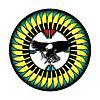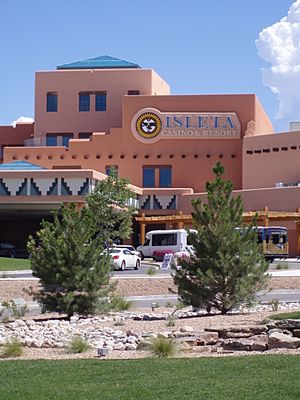Pueblo of Isleta facts for kids
Quick facts for kids
Pueblo of Isleta
|
|||
|---|---|---|---|
|
|||

Location of the Pueblo of Isleta
|
|||
| Country | United States | ||
| State | New Mexico | ||
| County | Bernalillo | ||
| Website | Pueblo of Isleta | ||
|
Isleta Pueblo (Shiewhibak)
|
|
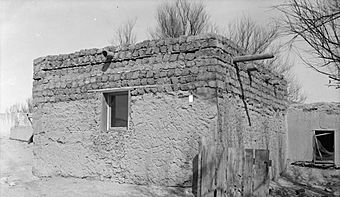
Ruins at Isleta Pueblo
|
|
| Location | U.S. 85, Isleta, New Mexico |
|---|---|
| Area | 211,000 acres (85,000 ha) |
| Built | 1613 |
| Architectural style | Pueblo Style |
| NRHP reference No. | 75001162 |
| Significant dates | |
| Added to NRHP | September 5, 1975 |
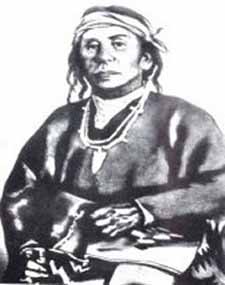
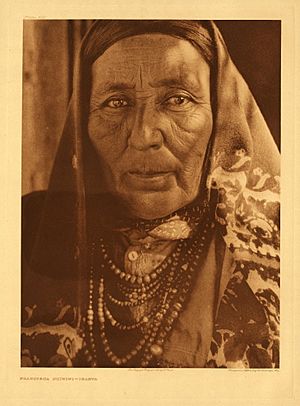
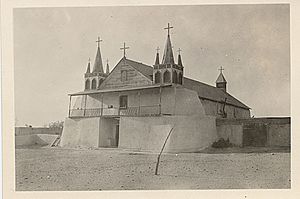
The Pueblo of Isleta is a special community and Tanoan pueblo (a type of village) in New Mexico, United States. It was first built around the 14th century. The people of Isleta are a federally recognized tribe, meaning the U.S. government officially recognizes them as a Native American nation.
The Isleta Pueblo is located in the Middle Rio Grande Valley, about 13 miles (21 km) south of Albuquerque. It sits on a unique, knife-shaped lava flow. The historic area of Isleta Pueblo is listed on the National Register of Historic Places because of its importance.
In 2016, the Isleta tribe bought back a large amount of land, about 90,151 acres (140 square miles). This land was once part of their original homeland. The U.S. government then officially placed this land into a "federal trust" for the tribe. This was a big deal, as it increased their land by 50%! The tribe had worked for over 20 years to get this land back.
Contents
Culture and Traditions
Language and People
Most people in the Pueblo of Isleta belong to the Southern Tiwa group. They traditionally speak Isletan Tiwa, which is a unique language. It's one of two types of the Southern Tiwa language. The other type is spoken at Sandia Pueblo.
In 2015, the tribe announced that the Tiwa language would be taught to children at Isleta Elementary School. This happened after the school came under the tribe's control. In 2016, money was given to help create a special program. This program teaches young children both Tiwa and English.
Traditional Ways of Life
Experts often divide Pueblo groups into different types based on their traditions. Isleta is considered an "Eastern Pueblo." This means they traditionally used irrigation to grow their crops, like corn, squash, and beans. This is different from "Western Pueblos" who often relied on dry farming methods.
Family and Community
The Isleta people have a matrilineal system. This means that family lines and important traditions are passed down through the mother's side of the family. Children are considered part of their mother's family or "corn group," which is like a clan. They also have a system where people usually marry within their own group. These family and cultural groups are connected to sacred directions, colors, and different parts of the community. For example, one group might be linked to winter traditions, and another to summer traditions.
Spiritual Practices
The tribe has a special sacred space called a kiva. This is used for important rituals and ceremonies. Their traditional religion includes the cult of the Kachinas. Kachinas are spiritual beings that represent different parts of the spirit world and nature.
The idea of Kachinas has three parts:
- The spiritual being itself.
- The kachina dancers, who are masked community members that act as Kachinas in ceremonies.
- Kachina dolls, which are small carved dolls given to children as gifts.
It's thought that the Kachina traditions might have spread to Isleta from other Pueblos further west.
History of Isleta Pueblo
Early Days and Spanish Arrival
When the Spanish arrived in the late 1500s, they named the village Isleta. This is a Spanish word meaning "little island." In 1613, a Spanish friar named Juan de Salas built the San Agustín de la Isleta Mission church in the pueblo. He tried to teach the people about Catholicism and new ways of farming.
During the Pueblo Revolt of 1680, many Isleta people left their homes. Some went to Hopi villages in Arizona, while others followed the Spanish south to El Paso. After the rebellion, the Isleta people returned to their Pueblo. Many came back with Hopi spouses.
19th Century Changes
In the 1800s, some people from Laguna Pueblo and Acoma Pueblo joined the Isleta community. However, there was some disagreement, which led to the creation of a smaller settlement called Oraibi. Today, Isleta includes the main pueblo and the smaller communities of Oraibi and Chicale.
In 1891, a French missionary named Father Anton Docher came to Isleta. He became a priest at the historic St. Agustin Mission Church. He served there for 34 years until he passed away in 1928. He is buried near the church's altar. The church itself is very old, built by the Tiwa people under Spanish guidance in 1612. It's one of the oldest churches in the United States.
20th Century and Beyond
In 1919, the King of Belgium, Albert I, visited Isleta with his wife and son. The King honored Pablo Abeita, who was the Governor of the Pueblo, and Father Anton Docher. Governor Abeita gave the King a special turquoise cross made by the Isleta people. About 10,000 people came to Isleta for this important visit.
Pablo Abeita was also a leader in the Council of All Indian Pueblos. In the 1920s, this group worked to protect Native American lands from the U.S. government. The Isleta Pueblo had a special land title from the Spanish, which the U.S. had promised to respect after the Mexican-American War. Abeita and other leaders helped pass the Pueblo Lands Act of 1924, which confirmed their land rights.
Even so, the Pueblo continued to lose some of its lands over time. However, through court cases and hard work, the tribe has been buying back lands to rebuild their homeland. In the 2010s, the Pueblo leaders bought 90,151 acres (140 square miles) of land. This land was once part of their original territory. In 2016, the U.S. government officially placed this land into trust for the Pueblo. This increased the Pueblo's territory by 50%! This new land, known as Comanche Ranch, is used for one of the Pueblo's successful businesses, where they raise cattle.
Today, the Pueblo of Isleta has about 4,000 people and owns 211,000 acres of land.
Economy and Businesses
The Pueblo of Isleta has several successful businesses. Besides their cattle ranch, they own and run the Isleta Resort Casino. This is one of the biggest casinos in New Mexico. They also have the Eagle Golf Course and the Isleta Lakes Recreational Complex.
You can even get to the Isleta Resort Casino by train! The New Mexico Rail Runner Express commuter train has a stop at the Isleta Pueblo station. The casino also has its name on the Isleta Amphitheater, a large outdoor music venue.
Education
Children in the Isleta Pueblo area attend schools run by Albuquerque Public Schools.
The Bureau of Indian Education also operates Isleta Elementary School nearby. A new school building for Isleta Elementary opened in 2006.
The community also has its own public library, the Isleta Pueblo Library.
Images for kids
See also
 In Spanish: Pueblo de Isleta para niños
In Spanish: Pueblo de Isleta para niños



